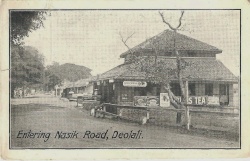Deolali
| Deolali | |
|---|---|

| |
| Presidency: Bombay | |
| Coordinates: | 19.8898025°N, 73.6792022°E |
| Altitude: | 515 metres (1,690 ft) |
| Present Day Details | |
| Place Name: | Deolali |
| State/Province: | Maharashtra |
| Country: | India |
| Transport links | |
Deolali was a cantonment in Nasik District, situated about 3½ miles to the south west of Nasik. It was established in 1869 and was used as a transit camp for nearly all troops proceeding to and from Bombay and Britain.
In addition to the soldiers assembled after finishing their tour of duty, the troops waiting there also included mentally ill soldiers sent from all over India, who were being repatriated to Britain on medical grounds. In the nineteenth century, troopships sailed on a seasonable basis only in winter and spring, and soldiers posted there after March had to wait until October or November before voyages recommenced. The slang words doolally or doolali, or doolali-tap, are used to describe someone who is "out of one's mind" or crazy. The second part is a Hindustani word for fever, although in Sanskrit,‘tapa’ means simply heat or torment. Taken literally, it is best translated as ‘camp fever’. These expressions are derived from Deolali, where some soldiers went mad, waiting for extended periods for ships to take them back to Britain.
Spelling variants
Deolali, Devlali
FIBIS resources
- FIBIS database Nashik Christian Cemetery. The cemetery is sometimes referred to as Deolali Government Cemetery. Inscriptions have been transcribed from gravestones at the cemetery. Images are also available, which are part of the FIBIS Cemeteries Project, and may be ordered for a modest donation.
Also see
External links
- History of Deolali Deolali Cantonment Board
- 1870 Photograph: A view of the Deolali cantonment near Nasik
- "The madness at Deolali" by N A Martin Journal of the Royal Army Medical Corps. 2006 Jun; 152 (2):94-5 , now an archived page.
- 34 Welsh General Hospital in Deolali during WW1
- From notes in the Australian Archives regarding 34 Welsh General Hospital in Deolali : Sister Alma L. Bennett, Matron in 1917, said: ‘containing 3000 beds – 4 hrs train journey from Bombay'. ... Our cases were all from Mesopotamia – some direct – others individually coming from various Bombay Hospitals… We also had 200 Turkish Prisoners of War, almost all Surgical cases, some with shocking wounds – septic.’ Matron Gertrude Davis said: ‘When we became a P. of W. hospital our number of beds was increased to 700, 200 for British and 500 for prisoners as later we had the German prisoners from East Africa also an occasional one from Mespot’. [1]
- Reading between unwritten lines: Australian Army nurses in India, 1916-19 by Ruth Rae Australian War Memorial website, archived page. Describes the 34th Welsh General Hospital (34 WGH) at Deolali
- Anzac Girls In India slq.qld.gov.au. Nurse Annie Grant Sim enlisted in the Australian Army Nursing Service, on 19 May 1917 and subsequently was assigned to No 34 Welsh Hospital, Deolali. She served in Bombay until April 1919.
- Who Do You Think You Are? - Alan Cumming. Alan’s grandfather was treated during World War 2 at Deolali - well known for housing psychiatric patients. However, this section was removed from his Army service record, perhaps because of the stigma attached to mental illness at the time. youtube.com
- Reminiscences of Professor R H Girdwood, Royal Army Medical Corps, WW2. He served at Deolali for a short period of time. scotsatwar.org.uk. now archived.
- Teenage Memories of World War 2: Part 3 by Stan Wood, part of the Royal Army Ordnance Corps. He left England for India in May 1943, travelling via Durban. In 1943 Deolali had a predominance of tents. (Scroll down). BBC's ww2peopleswar
- Voyage and Training from “Chindit Chasing, Operation Longcloth 1943” Scroll down to the section which mentions Deolali and includes a map of the Deolali Army Camp c 1945
- Photograph: Cathay Picture House, Deolali Captioned "My Grandfather, James Wilson. Serving with the Royal Artillery in India during WW2. Taken in Deolali, India in the 1940s."
- Westward Bound: Advice and Help for your Journey Home including "Part I:-What you need to know whilst you are at Deolali" and "Part IV Games, Amusements, Activities (Deolali)". Transcript of a booklet given to soldiers about to travel from Deolali back to the UK at the end of WW2. britain-at-war.org.uk
Historical books online
- Deolali Imperial Gazetteer of India, Volume 11, page 246.
- "Deolali Forty Years Ago" by Lieutenant-Colonel J G McNaught RAMC (retd.) page 270 Journal of the Royal Army Medical Corps, Volume 68 1937 Archive.org. The author was based at Deolali from 1895 for two years, and in 1900 for a year. He returned in 1918 for a visit.